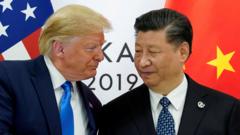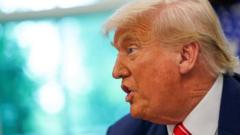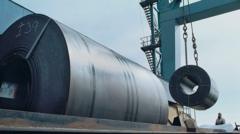**President Trump has raised tariffs on foreign steel and aluminum as part of a broader strategy to bolster domestic industries, triggering backlash from international allies and significant sectors that rely on these materials.**
**Increased Tariffs on Steel and Aluminum Imports Impact Global Trade Relations**

**Increased Tariffs on Steel and Aluminum Imports Impact Global Trade Relations**
**The latest U.S. tariffs double existing rates, igniting tensions with major trading partners.**
In a bold move to support the American steel and aluminum industry, President Trump has announced the doubling of tariffs on foreign imports from 25% to 50%. This decision, which took effect just after midnight Eastern time, is part of the administration's ongoing push to strengthen domestic production against what it describes as unfair trading practices threatening national security.
The president articulated the need for these increased levies during his recent visit to a U.S. Steel mill—an event seen as an attempt to garner political support from workers in key swing states like Pennsylvania. The White House has framed the increased tariffs as essential for combating countries that purportedly undersell their steel and aluminum into the U.S. market.
While some industry leaders, such as Kevin Dempsey of the American Iron and Steel Institute, have lauded the decision—claiming it will protect American jobs—reactions from U.S. allies have been swift and negative. Canada and European nations that export steel to the U.S. are already voicing concerns over the potential repercussions of such a drastic tariff increase.
The higher costs imposed on steel and aluminum imports will likely affect numerous sectors reliant on these metals, including automotive, aerospace, and construction industries. Experts warn that the amplified tariffs could lead to increased consumer prices and hinder manufacturing in these sectors, causing ripple effects throughout the economy.
As the U.S. implements this significant policy shift, the international community watches closely to gauge responses and possible retaliatory measures, emphasizing the complexities of global trade dynamics.
The president articulated the need for these increased levies during his recent visit to a U.S. Steel mill—an event seen as an attempt to garner political support from workers in key swing states like Pennsylvania. The White House has framed the increased tariffs as essential for combating countries that purportedly undersell their steel and aluminum into the U.S. market.
While some industry leaders, such as Kevin Dempsey of the American Iron and Steel Institute, have lauded the decision—claiming it will protect American jobs—reactions from U.S. allies have been swift and negative. Canada and European nations that export steel to the U.S. are already voicing concerns over the potential repercussions of such a drastic tariff increase.
The higher costs imposed on steel and aluminum imports will likely affect numerous sectors reliant on these metals, including automotive, aerospace, and construction industries. Experts warn that the amplified tariffs could lead to increased consumer prices and hinder manufacturing in these sectors, causing ripple effects throughout the economy.
As the U.S. implements this significant policy shift, the international community watches closely to gauge responses and possible retaliatory measures, emphasizing the complexities of global trade dynamics.





















